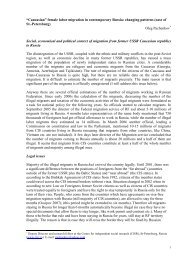THORIUM AS AN ENERGY SOURCE - Opportunities for Norway ...
THORIUM AS AN ENERGY SOURCE - Opportunities for Norway ...
THORIUM AS AN ENERGY SOURCE - Opportunities for Norway ...
Create successful ePaper yourself
Turn your PDF publications into a flip-book with our unique Google optimized e-Paper software.
Nuclear Reactors <strong>for</strong> Thorium<br />
• Additional measurements of the absorption cross sections of the salt constituent Li, Be, and F<br />
could reduce the uncertainty further.<br />
• Verifying the temperature coefficients of reactivity, including Doppler coefficients.<br />
Chemistry: An extensive program of molten-salt chemical research over the past 40 years has<br />
established a sound basis <strong>for</strong> understanding the chemistry of the pertinent fluoride salts.<br />
Additional work is desirable, however, in several areas:<br />
• A better understanding is needed of the behaviour of the noble metal fission products in MSBR<br />
systems.<br />
• Alternative processes <strong>for</strong> rare earth removal should be investigated, and chemical in<strong>for</strong>mation<br />
on the protactinium removal process needs to be extended to a wider range of conditions.<br />
• The phase behaviour of PuF3 in molten salts ought to be studied more thoroughly to provide a<br />
firmer chemical basis <strong>for</strong> the use of plutonium.<br />
• Further measurements are needed of the physical and chemical properties of molten salts, and<br />
particularly of the sodium fluoride/sodium fluoroborate salt mixtures which are the presently<br />
proposed secondary coolants <strong>for</strong> MSBRs.<br />
Fuel Processing: Obtaining good breeding in a single-fluid reactor requires rapid on-site<br />
reprocessing to keep protactinium out of the high neutron flux as well as to remove fission<br />
products. The investigation of most of the steps needed to effect rapid reprocessing has not<br />
proceeded past preliminary laboratory tests.<br />
Materials: Damage from high-energy neutrons eventually leads to deterioration of graphite at<br />
temperatures of interest <strong>for</strong> molten-salt reactors, and improved grades need to be developed and<br />
tested. The Hastelloy-N used in the past <strong>for</strong> containing molten salts is embrittled by helium<br />
produced in the metal when it is irradiated. Although the present material has been satisfactory<br />
<strong>for</strong> the Molten Salt Reactor Experiment (MSRE), an improved alloy is needed <strong>for</strong> power reactors.<br />
The resistance of the modified alloy to corrosion by fuel and coolants salts, particularly the<br />
fluoroborate, must be demonstrated at all reactor operating conditions.<br />
Molten Salt Reactor Experiment (MSRE): MSRE operation has shown the compatibility of<br />
graphite with fissioning fuel at low power densities and low burnup, and a variety of in-pile<br />
capsules and loops have provided additional in<strong>for</strong>mation. However, the experience to date has not<br />
included exposures at the power densities of breeder reactors. In-pile loop experiments thus need<br />
to be per<strong>for</strong>med using appropriate materials at the peak power densities of high-per<strong>for</strong>mance<br />
breeders.<br />
5.4.4 Accelerator Driven System (ADS)<br />
An Accelerator Driven System (ADS) is a subcritical reactor, i.e. a reactor that cannot sustain a<br />
chain reaction on its own. The reactor can only run when neutrons are supplied from an external<br />
source. In the case of the ADS, the neutrons come from spallation of heavy nuclei like lead. In this<br />
context, spallation means that a high energy proton (500 - 1000 MeV) hits an atomic nucleus in a<br />
target (e.g. lead) and rips off a large number of neutrons (15 - 30), depending on the target<br />
material and the proton energy. The collision between the proton and the target nucleus may also<br />
result in fissioning of the nucleus, or the production of nuclei of light elements. Further, the<br />
neutrons that are produced will induce fission and nuclear transmutation reactions in the fuel.<br />
The high energy protons are supplied by a powerful particle accelerator which may be either a<br />
linear accelerator (LINAC) or a cyclotron.<br />
55

















